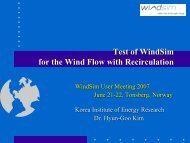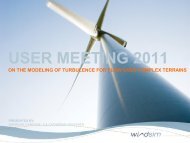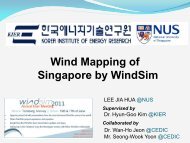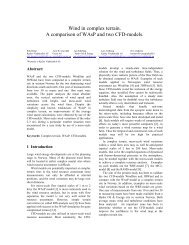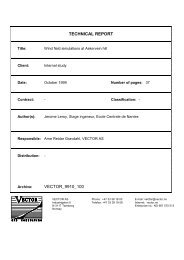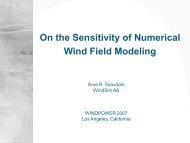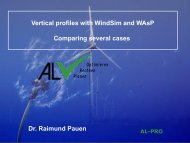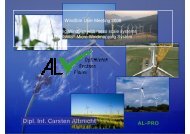wind energy resource evaluation in a site of central italy ... - WindSim
wind energy resource evaluation in a site of central italy ... - WindSim
wind energy resource evaluation in a site of central italy ... - WindSim
You also want an ePaper? Increase the reach of your titles
YUMPU automatically turns print PDFs into web optimized ePapers that Google loves.
6.6 Turbulence Intensity Vertical Pr<strong>of</strong>ilesIn this paragraph vertical pr<strong>of</strong>iles <strong>of</strong> turbulence <strong>in</strong>tensity (T.I.) are reported andanalyzed. The figures 6.5 and 6.6 show the comparison between the measuredturbulence <strong>in</strong>tensity values and the results <strong>of</strong> CFD simulation.The experimental T.I. values have been calculated by the time-history <strong>of</strong> <strong>w<strong>in</strong>d</strong> dataas a ratio between the standard deviation <strong>of</strong> <strong>w<strong>in</strong>d</strong> velocity and the mean <strong>w<strong>in</strong>d</strong>velocity evaluated for the <strong>in</strong>stantaneous measurements taken <strong>in</strong> 10 m<strong>in</strong>utes6.3.3) . .=whereσ is the standard deviation <strong>of</strong> <strong>w<strong>in</strong>d</strong> velocity [m/s]U is the mean velocity [m/s]By organiz<strong>in</strong>g experimental data for <strong>w<strong>in</strong>d</strong> direction it is possible to group theseangles <strong>in</strong> sectors (<strong>in</strong> the specific case one sector every 30° for a total <strong>of</strong> 12 sectors)and to consider the <strong>w<strong>in</strong>d</strong> velocity and the associated T.I. value. Then, it is possible tocreate twelve scatter graph, where T.I. is a function <strong>of</strong> U. In general, these graphsshow a cloud <strong>of</strong> po<strong>in</strong>ts that can be approximate by an hyperbolic function. Datareach<strong>in</strong>g an <strong>in</strong>f<strong>in</strong>ite value <strong>of</strong> T.I. for low <strong>w<strong>in</strong>d</strong> velocity are present while the expectedtrend goes toward zero when <strong>w<strong>in</strong>d</strong> velocity grows. The common practice elim<strong>in</strong>atesthe high values <strong>of</strong> turbulent <strong>in</strong>tensity associated to low <strong>w<strong>in</strong>d</strong> speed, that areprobably affected by thermal effects, when an <strong>in</strong>terpolation <strong>of</strong> the cloud <strong>of</strong> po<strong>in</strong>ts isrequired. Accord<strong>in</strong>g to this practice rule the TI was evaluated reject<strong>in</strong>g the valuesconnected to low mean <strong>w<strong>in</strong>d</strong> velocity. The threshold value was chosen follow<strong>in</strong>g theconclusions <strong>of</strong> the previous paragraph 6.5, where a threshold range was <strong>in</strong>dicated <strong>in</strong>U30 = 3÷4 m/s. In these particular analysis the value <strong>of</strong> U=4 m/s has been used t<strong>of</strong>ilter experimental data.The CFD simulations did not take <strong>in</strong>to account thermal effects, thereafter underestimat<strong>in</strong>g the turbulence <strong>in</strong>tensity data. A procedure <strong>of</strong> reject<strong>in</strong>g these data is thenneeded to reduce the thermal effects <strong>in</strong> the experimental data used for comparison.101




